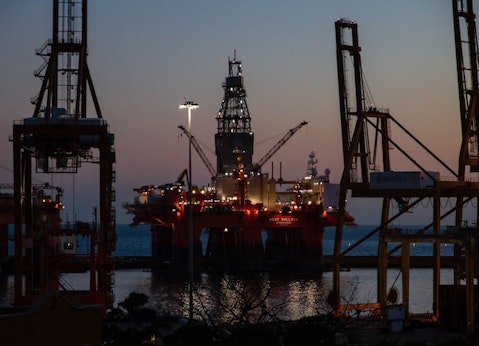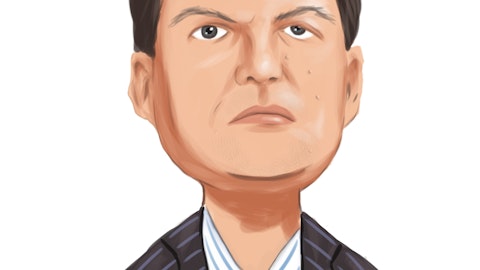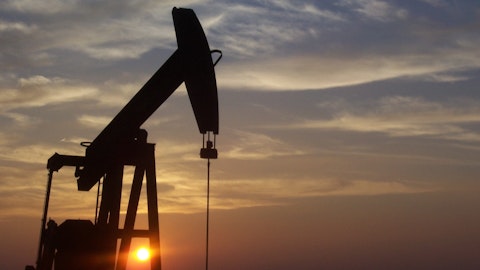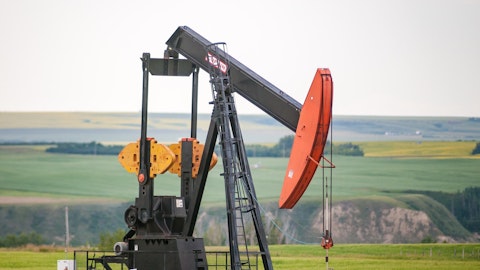Precision Drilling Corporation (NYSE:PDS) Q4 2022 Earnings Call Transcript February 9, 2023
Operator: Good day, and thank you for standing by. Welcome to the Precision Drilling Corporation 2022 Fourth Quarter and Year-End Results Conference Call. I would now like to hand the conference over to Lavonne Zdunich, Director of Investor Relations. Please go ahead.
Lavonne Zdunich: Thank you, operator. Welcome everyone to Precision Drilling’s Fourth Quarter and Year-End Earnings Conference Call and Webcast. Today, I’m joined by Kevin Neveu, our President and CEO; and Carey Ford, our CFO. Earlier this morning, Precision reported strong fourth quarter results, capping off a very successful year. Carey will review these results with you, followed by an operational update and outlook commentary from Kevin. Once we have finished our prepared comments, we will open the call to questions. Please note that some of our comments today will refer to non-IFRS financial measures, and will include forward-looking statements, which are subject to a number of risks and uncertainties. For more information on financial measures, forward-looking statements and risk factors, please refer to our news releases and other regulatory filings.
As a reminder, we expressed our financial results in Canadian dollars unless otherwise indicated. With that, I’ll turn it over to Carey.
Carey Ford: Thanks, Lavonne, and good afternoon. Precision’s annual financial results showed significant improvement from 2021 to reflect the focus of the 2022 strategic priorities that Kevin will review in his commentary. A few of those highlights include: revenue of $1.6 billion, a 64% annual increase; adjusted EBITDA of $312 million, increasing 62%; funds from operations of $283 million, increasing 86%; cash from operations of $237 million, increasing 70%; debt reduction of $106 million, exceeding our $75 million debt reduction target; and $10 million in share repurchases. Moving on to our fourth quarter results. Our fourth quarter adjusted EBITDA of $91 million increased 43% from the fourth quarter 2021 and was supported by higher North American activity and day rates.
Also included in adjusted EBITDA during the quarter is share-based compensation expense of $75 million. And absent this accrual, adjusted EBITDA would have been $166 million. More on the share-based compensation accrual in a moment. The margin performance of the business started to accelerate in the second half of 2020 and with Q4 adjusted EBITDA before share-based compensation percentage — as a percentage of revenue of 33% compared to 24% in Q4 2021. As we focus on revenue efficiency in 2023, growing these margins will — further will be a priority. In the U.S., drilling activity for Precision averaged 60 rigs in Q4, an increase of 3 rigs from Q3. Daily operating margins in the quarter after impacts of turnkey and IBC were US$11,849, an increase of US$2,187 from Q3 and exceeding our previous guidance.
For Q1, we expect normalized margins to increase another US$2,000 per day from Q4 levels. In Canada, drilling activity for Precision averaged 66 rigs, an increase of 14 rigs or 27% from Q4 2021. Daily operating margins in the quarter were $12,348, an increase of $2,314 from Q3 2022, and ahead of our prior guidance. For Q1, we expect margins to be relatively flat due to a higher percentage of shallower rigs active, lower expected boiler revenue at the end of the quarter and seasonal timing of pricing renewals. Internationally, drilling activity for Precision in the quarter averaged 6 rigs and average day rates were US$49,918, down approximately 4% from the prior year due to active rig mix. We expect to add 2 additional rigs in Kuwait when the new contracts begin this summer.
Because certain of these rigs will be off-line and undergoing certification in the first half of the year, we expect 2023 activity to be only slightly higher than 2022 on an annual basis, despite having 8 rigs running by the end of the summer. 2024 activity should increase by 30-plus percent over 2023. In our C&P segment, adjusted EBITDA this quarter was $12 million, up over 91% compared to the prior year quarter. Adjusted EBITDA was positively impacted by a 49% increase in well service hours reflecting the impact of the High Arctic acquisition and higher industry activity in the quarter. We expect results will further strengthen in Q1 with increased rates and activity and full realization of our transaction synergies. Capital expenditures for the quarter were $57 million and $184 million for the year.
Our capital expenditures were slightly higher than our guidance of $165 million due to timing of equipment deliveries. Our 2023 plan is $235 million and is comprised of $163 million for sustaining and infrastructure and $72 million for upgrade and expansion. The upgrade and expansion portion relates to anticipated investments supporting Alpha technologies’ EverGreen environmental solutions and contracted customer upgrades, which includes a Super Triple conversion for the Canadian market on a 3-year contract that requires approximately $17 million of capital from Precision. Kevin will discuss this project in more detail later in the call. Of the $163 million in maintenance, approximately $30 million relates to the Kuwait rig certifications associated with 4 rigs contracted for a 5-year term and approximately $20 million related to international drill pipe deliveries.
Our capital spending plan is generally flat year-over-year before adding the capital for four multiyear contracts in Kuwait and the one multiyear contract in Canada. As of February 8, we had an average of 58 contracts in hand for the first quarter and an average of 49 contracts for the full year 2023. We now have 17 rigs on contract in Canada for 2023, reflecting an increasing number of customers seeking to lock up rigs ahead of LNG project starts. Moving to the balance sheet. We continue to reduce both absolute and net debt levels, primarily through free cash flow generation and succeeded in reducing debt by $106 million in 2022. As of December 31, our long-term debt position, net of cash, was approximately $1.1 billion, and our total liquidity position was approximately $600 million, excluding letters of credit.
As a reminder, all our outstanding debt is denominated in U.S. dollars and reported values within our financial statements will vary based on changes in the USD, Canadian dollar exchange rate. Our net debt to trailing 12-month EBITDA ratio is approximately 3.4x and average cost of debt is 7.1%. With continued debt reduction and activity expectations, we believe we will end 2023 with a net debt-to-EBITDA ratio of between 1.25x and 1.5x, moving Precision closer to our updated goal of below 1x. For 2023, we expect to generate strong free cash flow for the year, with Q1 cash flow impacted by front-end loaded CapEx, working capital build, our semi-annual interest payments and year-end payments. Our year-end target for debt reduction is at least $150 million, and we will target our revolver balance and 2026 notes that are callable at par in the fourth quarter.
Additionally, we plan to allocate 10% to 20% of free cash flow before debt principal payments to share repurchases. Now I would like to cover some details on the share-based compensation plan Precision has in place. Our plan is similar to other corporate plans, but the cash settled accounting creates quarter-to-quarter volatility in the accruals that can be challenging to follow. We accrued $75 million in share-based compensation charges for the quarter and $134 million for the year, where approximately $74 million relates to potential payments in Q1 2023 and $60 million relates to potential payments in 2024 and 2025. Our long-term incentive awards are granted at the beginning of each year to motivate executives and key employees over a 3-year vesting period and are — and to align Precision’s long-term goals and shareholders’ interest.
Our share-based portion of compensation have averaged approximately $25 million at the grant date for each of the past five years. The awards vest over time and are impacted positively or negatively by changes in Precision’s share price and a performance multiplier between 0x and 2x, which is calculated based on relative share performance and certain long-term strategic initiatives. For the 2020 grants, which remain early in Q1 2020 before the impacts of COVID-19 and despite the uncertainty and challenging macroeconomic events caused by COVID-19, no adjustments were made to award amounts, total shareholder return requirements or long-term strategic initiatives over the 3-year period. Precision’s business and share price performance have performed exceptionally well since the grant date.
At the end of 2022, the performance multiple changed from 1x to 1.49x for the accrual. This was based on Precision’s 3-year total shareholder return performance of 186%, the second highest within Precision’s defined peer group of 16 companies and indices, which accrued a performance multiplier of 1x. Additionally, Precision nearly achieved a long-term debt reduction target, which accrued a multiplier of 0.49x and failed to achieve a leverage ratio target, which accrued a multiplier of 0x. The multiplier change impacted the accrual for a portion of share-based compensation to be paid out in Q1 2023. So now we’re moving on to the share price. In addition to Precision’s exceptionally strong share price performance in the quarter, which increased 48% from the end of Q3, the increase in share price required a change in accrual for the plans to be paid out in the first quarters of ’22 — 2023, 2024 and 2025.
This is a mark-to-market exercise that has performed every quarter. I’ll take a breath. Thank you for your patience with that explanation. Now let’s move on to guidance for 2023, where we expect to have depreciation of approximately $285 million; cash interest expense of approximately $80 million; cash taxes to remain low; and our effective tax rate to be approximately 25% as we continue to return to profitability in 2023; SG&A to be approximately $95 million before share-based compensation expense; and share-based compensation expense accruals of approximately $30 million to $40 million for the year, with a Canadian dollar share price in the $80 to $100 range. For 2023, we expect the share-based compensation accrual to move approximately $600,000 per $1 change in share price in either direction within this general range.
I will now turn the call over to Kevin.

Photo by Maria Lupan on Unsplash
Kevin Neveu: Thank you, Carey. I’m very pleased with the performance of our business during the fourth quarter and for the full year of 2022. And as Kerry mentioned, we achieved success on all last year’s strategic objectives and this positions us very well for a running start into 2023. Revenue growth was strong. Margin growth was stronger and capital discipline remains a key element of our financial strategy. Last quarter, we achieved and are sustaining of 100% or sold out utilization with our Super Triple rigs in the Canadian market. We reactivated and are sustaining approximately 90% utilization on our U.S. Super Triple fleet. We re-contracted six of our natural rigs for a 5-year period with over $800 million of contracted international backlog.
AlphaAutomation is now viewed as an industry standard for rig automation and is designed — customer desires add-on to virtually all of our operating Super Triple rigs. During 2022, we leveraged our successful Alpha business model to introduce the EverGreen product line, where we exceeded our first year market penetration expectations with this exciting new GHG reduction initiative. There’s no question that our success is from the efforts, the energy and the intense focus of Precision’s team apply to our strategy and then delivering strong results. Looking back not too long ago, there was a period in 2020 early in the pandemic that many questions the survivability of our industry and Precision. The pandemic collapse came just after we launched the commercialization of our AlphaAutomation platform.
Despite those challenging times, our people stay focused. We’ve doubled down their efforts on our strategy, our technology, free cash flow and they reinforced our products culture. The momentum we created during that period has served Precision well as the industry rebounded in 2021, 2022, and as the rebound continues in 2023. For 2023, Precision’s strategic objectives are: one, elevating our high-performance, high-value strategy, which encompasses safety, rig efficiency, Alpha and EverGreen and most importantly, our value proposition to our customers; two, maximize free cash flow, including driving field margins towards 50% in the North American drilling business, among other internal financial targets; and three, as Carey covered earlier, accelerating our capital structure plans by increasing our short-term and long-term debt reduction target, tightening leverage target and continuing to prioritize 10%, 20% of free cash flow for share repurchases.
Capital deployment is critical to Precision. We intend to maintain investor confidence with strict capital discipline. Now turning to our operations. I’ll start with the Lower 48. Natural gas price weakness likely will have some influence on customer planning despite the strong gas hedge positions across the gas producers. Since the beginning of this year, we’ve actually re-contracted 12 gas rigs with the same clients, and three other gas rigs have been re-contracted to new clients. So we’ve seen minimal turnover so far. Currently, we have 85% utilization of our Super Triple rigs and those active or hot rigs remain highly desired by customers, whether they’re in gas or oil. It’s our expectation that nat gas customer demand will likely be taken up by customers looking closely at Precision’s Super Tripe rigs, especially with our AlphaAutomation capabilities.
Day rates remain firm with leading edge rates in the range. We expect to continue repricing our currently contracted rigs with existing price environment as our contracts renew over the course of 2023. The themes of many, if not most, E&P capital spending programs were based on conservative price decks and they’ve covered with hedges to mitigate the risk to the volatile commodity prices. We did not see rig demand boom like in prior cycles in response to the high commodity prices of early last year, and we expect customer demand to remain moderate and disciplined and somewhat insulated from the commodity volatility we experienced recently. Of course, we all understand the potential risks of the global recession or a meaningful slowdown and the potential impact on commodity prices and customer demand.
Today, we have 61 rigs running and expect to be in this range plus or minus for the first quarter. We expect our EverGreen solutions will gain wider customer penetration in Lower 48 during 2023 and the compelling economics of the diesel fuel savings and for some regions, the GHG reduction these products offer make good sense for our customers. Turning to Canada. The Canadian market looks very good indeed. Notably, the recent agreement reached between certain First Nation’s groups and the Province of British Columbia has clarified the licensing process for oil and gas activity in Northeastern B.C. We see several operators looking to deploy capital for drilling programs, which are likely targeting future LNG exports, and we have already experienced multiple inbound inquiries seeking additional Super Triple rigs.
Several current customers are now requiring about long-term take-or-pay contracts to lock in with for multiyear programs, breaking away from the traditional Canadian no obligation pricing agreements to all contracts in the past. Currently, we are 100% utilized with 28 Super Triples running. This is the first time this has happened for Precision in any rig class in our history. In response to this demand, we have previously announced one additional Super Triple rigs expected to go to work in March. This rig was redeployed last year. Additionally, we have recently signed a contract for a substantial upgrade to create another Super Triple class rig, which will be deployed in January 2024. This new class upgrade is backed by a 3-year term contract and mid-40,000 day rate or the base rate.
By early next year, and actually clarify a mid-40,000s dollar day rate for the base rate. By early next year, we will have 30 Super Triple rigs in the Canadian market. We have a couple of more redeployment candidates in the U.S. and several other possible upgrade candidates, but we’ll remain highly disappointed in how we proceed ensuring we meet our expected returns and sustained market supply potential. Now moving to Clearwater play for a moment, I thought it would be beneficial to spend a little time explaining this story to our investors. First of all, the Clearwater formation is a high permeability conventional heavy oil play that doesn’t require speed and doesn’t require hydraulic simulation. These are relatively inexpensive and low cost curve oil wells, typically costing $1.2 million to $1.7 million per well.
The operators are reporting that these wells are 1/2 cycle breakeven at around US$20 per barrel of oil equivalent, which on that basis, these are lowest cost oil wells in North America. The Clearwater wells are actually fairly complex. The vertical legs are 600 to 900 meters and the horizontal section is a multilateral with a working two to eight separate horizontal legs built from one vertical wellbore. The horizontal legs can be from 1,000 to 2,500 meters or longer for wellbore horizontal sections of 10,000 meters or more per vertical wellbore. From a drilling perspective, the Clearwater play has legs, both metaphorically and physically. These wells are drilled on pads and the pad prices range from two to eight wells per pad. As we said in prior calls, this drilling is ideally Precision’s Super Single style rig.
With this rig, we typically drill these complex multilateral wells from 12 to 14 days each. Precision enjoys a 45% market share in the Clearwater where we have similar market shares for all heavy oil and sand drilling in Canada. Today, we have 43 Super Singles running with about 85% utilization, again, the highest since 2014. We’re operating 78 rigs total in Canada and expect to peak at 79 or 80 later this month, with spring breakup linked to weather not customer budgets. Customer demand looks strong for the balance of 2023 and beyond. The second quarter, our breakup of shaft activity level looks to be around 40 rigs compared to 19 last year. This higher level was driven largely by sustained pad activity in the Montney and Clearwater. We’re projecting our average activity for the quarter to be in the 45 to 46 rig range, up approximately 25% last year.
In our Canadian well service business, as Carey mentioned, the integration of the High Arctic business is effectively behind us, and we’re on track to achieve the expected synergies. Activity and customer demand remains strong, industry service rig requirements and labor constraints continue to support strong pricing tension. Precision’s well service team continues to manage strong customer demand and labor recruiting challenges, cost inflation, all while increasing margins and returns for investors. Today, we’re operating 68 service rigs, and we see additional customer demand where we are up to 10 rigs in a given day. Last year, we combined the management of our oilfield rentals business with our camps and catering business to reduce overhead and streamline the operation.
These changes, along with strong customer demand and improved equipment utilization, transform this business becoming a meaningful contributor to our Completion and Production Services unit. Turning to our International segment. We mentioned earlier, we previously announced contract awards in Kuwait and Saudi Arabia, and we remain on schedule to be running at least 8 rigs for that reason later this year. Currently, we’re bidding for multiple opportunities to activate several of our idle rigs also in the region. And we’re also looking at other Arabian Gulf regional opportunities for both our Super Singles and our Super Triples. International demand is certainly in the rise with the tender to contract to rig activation cycle is usually measured in months and quarters.
We hope to have more news in our financial report later this year. I’ll now turn the call back to the operator for questions. But before I do, I’d like to thank the employees of Precision Drilling for their hard work, dedication and the results they have put to deliver last quarter and last year. Thank you. And now back to the operator for questions.
Operator: Can you hear me?
Kevin Neveu : So while we’re waiting on the operator, certainly is a technical issue with the feed right now. But certainly we do expect questions and prepare to have many questions. We are still waiting the operator to interject here and take questions. There seems to be an issue right now with the conference provider. I’ll just comment that on the feed that we have right now, we can see that we have at least seven questions from the analysts that we’re trying to insert. But we are still waiting on the operator to join the call.
Operator: And this is the operator, I’m back. Can you hear me?
Kevin Neveu : Yes, we can hear you now. Thank you.
See also 12 NASDAQ Penny Stocks Under 10 Cents and 10 Most Advanced Countries in Battery Technology.
Q&A Session
Follow Precision Drilling Corp (NYSE:PDS)
Follow Precision Drilling Corp (NYSE:PDS)
Operator: First question comes from Wawar Syed with ATB.
Waqar Syed : Kevin, I didn’t hear you clearly. For this rig upgrade, the super spec in Canada, did you say that the day rate was mid $40,000 a day. What was the day rate at which it was contracted?
Kevin Neveu : Waqar, yes, thanks for the question. And I understand there may have been some muffling on the call. So I’ll clarify that. What I was saying was the day rate is in the mid-40,000s. So I think that would be in the range of $44,000 to $46,000 per day.
Waqar Syed : Well, is this a new high or for that class of rig in Canada?
Kevin Neveu : Certainly, it is. It’s going to be a Super Triple ST-1500 rig with remote sport generators and — we expect to have some additional add-ons above that rate that will include our technology, the technology and expect also there’ll be some EverGreen products on top of that rig. So the all-in rate for that rig could easily move into the low 50s.
Waqar Syed : And is there anything in particular that would keep the cost may be higher than the average in Canada?
Kevin Neveu : This is simply a rig upgrade. We’re seeking economics that meet our thresholds, hence, the day rate being in the mid-40s for the base rig but it’s an ST-1500 winterized with cold weather gear. Otherwise, conversion ST-1500 three-pump rig in West Texas.
Waqar Syed : Sure.
Kevin Neveu : And then walking in all the basic equipment on the rig you’d expect on a 1,500 horsepower high spec rig.
Waqar Syed : And what was the class of rig before the upgrade?
Kevin Neveu : It was actually a DC SCR 1,500 horsepower rig.
Waqar Syed : Okay. Great.
Kevin Neveu : In the past, we talked about those upgrades being $10 million to $12 million, but this would be a Canadian style inflated heated boilers. So that’s why the cost would be a little higher than
Carey Ford : Canadian dollars.
Kevin Neveu : than Canadian dollars. Thank you, Carey.
Waqar Syed : And then my second question relates to the Haynesville. You have a number of rigs working for one particular private customer — could you talk about the contract status there for that rig for those rigs? And maybe any color that you can provide for your Haynesville exposure?
Kevin Neveu : Well, I can’t. But what I can tell you is I did have a comment on, I think it was 12 rigs that repriced and removed during the first month of the year, and most of those were Haynesville rigs.
Operator: Our next question comes from Keith Mackey with RBC.
Keith MacKey : Maybe just to start off, Kevin, in your comment in the press release, you talked about moving margins to 50%. Can you just talk a little bit more about what’s required to get there? Do you need to increase the rig count from where it currently is? Or with the 60 rig number, can you actually get to the 50%? And then just what time frame do you think there is on that? Do you see getting cash gross margins in the U.S. by the end of this year? Or if you could just kind of help us frame that up, that would be good.



